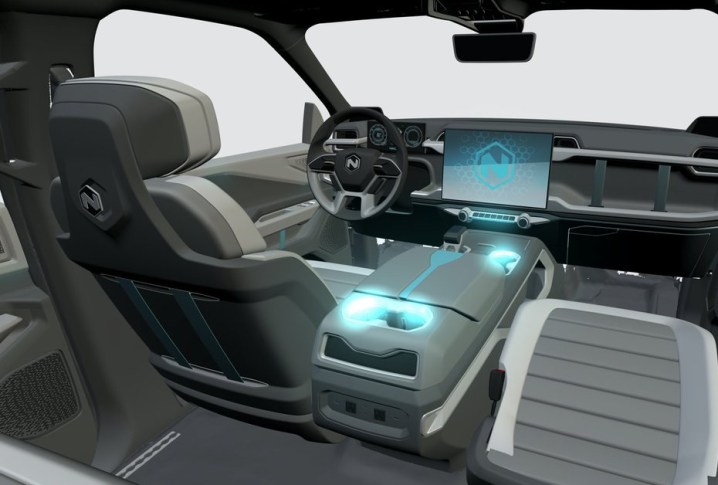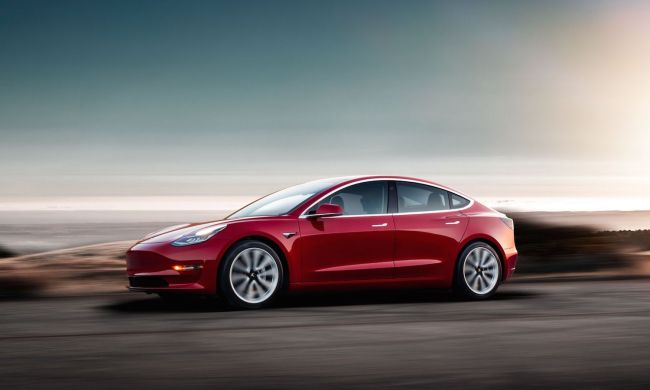Nikola sounds like Tesla’s other half — both are named after inventor Nikola Tesla, but the two companies are on track to become bitter rivals. Although Tesla is better established than its smaller, younger rival, investors have shown a tremendous (and surprising) amount of confidence in Nikola’s ability to claw its way to the top of the automotive food chain. Its answer to the electric Cybertruck is a pickup named Badger, which packs a battery-powered drivetrain (though it can run on hydrogen for better range) in a wrapper that puts an unmistakable focus on ruggedness.
Badger production is tentatively scheduled to start in 2021, though details are extremely murky. While we wait to see how the company’s plans develop, we’re taking a look at the truck’s specifications, design, and price. Keep in mind it’s not in production yet, the images you see in this story are computer-generated renderings, and everything we’re listing (including horsepower, range, and pricing) is subject to change in the coming months. Electric pickups are the talk of the town in 2020, but there is still not a single model you can buy new in the United States as of writing.
What is it?

Nikola stylists gave the Badger a tough, go-anywhere design that borrows a handful of styling cues from some of the most off-road-capable trucks on the market. The NIKOLA lettering that stretches across the front end reminds us of the Ford F-150 Raptor, but LED lighting gives the truck a digital stare that helps set it apart from other pickups. The variant shown in the company’s renderings rides on beefy tires, and it’s equipped with small bumpers that increase its approach and departure angles. Odds are cheaper, more basic versions of the Badger will join the lineup as well.
Only a four-door model has been shown so far, and we don’t know whether additional body styles will be available. It stretches 231 inches long, 86 inches wide, and 74 inches tall, dimensions that make it about as long and as tall as Ford’s perennially popular F-150 but quite a bit wider. Its gross vehicle weight rating (GVRW) hasn’t been published, and it’s what will ultimately define whether the Badger falls in the same segment as the F-150 or if it competes against the bigger Super Duty. For example, the aforementioned Cybertruck is a class above the F-150.
What’s it like inside?

Nikola released a sketch of the Badger’s interior showing a four-spoke steering wheel, a digital instrument cluster, and a television-like screen propped up on the dashboard that’s allegedly waterproof. It looks like the truck offers seating for five passengers, and the company said it plans to integrate a small fridge somewhere in the cabin.
What’s under the sheet metal?

Although technical specifications remain vague, we know Badger buyers will have two powertrains to choose from. One is entirely electric: It consists of four electric motors (one behind each wheel) that presumably draw electricity from a huge lithium-ion battery pack mounted under the passenger compartment and/or beneath the cargo box. Nikola quotes a 300-mile driving range. If that’s not enough, the Badger will be available with a hydrogen-electric hybrid system that will unlock approximately 600 miles of range. The catch is that you’ll need to find somewhere to fill up; charging stations outnumber hydrogen refueling stations by a mile-wide margin, even in markets like California.
On its website, Nikola lists peak horsepower and torque outputs of 906 and 980, respectively, and a 2.9-second sprint from zero to 60 mph. “Peak” is the key word here, and those figures are likely only valid when a temporary overboost function kicks in. Continuous horsepower is rated at 455, so that’s what you’ll have under your right foot in normal driving conditions, and the Badger can tow up to 8,000 pounds when it’s properly equipped.
Hydrogen-powered cars emit water vapor, which is harmless enough to earn them the coveted “zero-emissions” label. Nikola plans to capture the droplets and use them to feed an in-car water fountain; seriously.
How much will it cost?

Pricing for the hydrogen-powered Badger starts at $60,000, according to Car & Driver, while the electric model’s base price will be pegged in the vicinity of $80,000. Some motorists will be eligible to claim a one-time $7,500 tax credit from the federal government. Buyers who want to secure an early build slot can send Nikola a refundable deposit, and company founder Trevor Milton pledged to keep the money his company receives in an account until deliveries start instead of using it to fund its research and development effort. That’s a direct shot at Tesla.
To generate interest, and to increase the number of reservations made, Nikola said it will match every deposit it receives. If you put down $250, the company will give you a $250 discount on the final purchase price. If you put down $5,000, you’ll get a $5,000 discount. Reservation holders will be entered in a drawing to win a free truck.
When can I drive one?

Nikola plans to introduce the Badger during an event it named Nikola World that’s taking place between December 3 and 5, 2020. Although the company hasn’t revealed precisely when it will begin delivering the model, it’s reasonable to assume that won’t happen before it’s unveiled on December 4, so the first trucks likely won’t end up in customer hands until 2021 at the earliest. There is yet another question mark hovering around Nikola’s production plans. It explained it will design the truck in-house, but it will outsource production to another automaker whose identity hasn’t been made public yet. Odds are production will take place somewhere in the United States, however.



